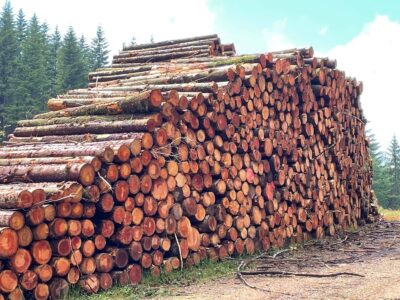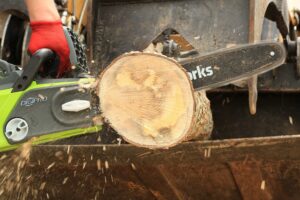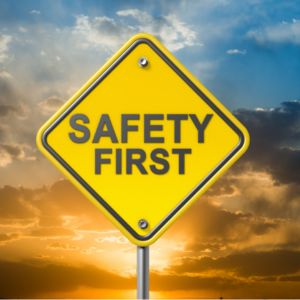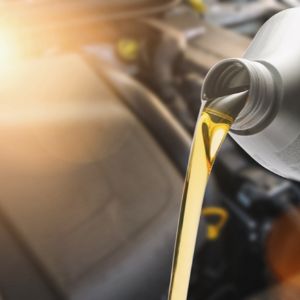Choose a Mini Chainsaw Carefully!
[no_toc]
 There are so many mini chainsaws on the market today that choosing a mini chainsaw to suit your needs can become a bit of a lottery.
There are so many mini chainsaws on the market today that choosing a mini chainsaw to suit your needs can become a bit of a lottery.
This situation is compounded by the fact that:
- many of the brand names are not known and very few of them are associated with well known chainsaw manufacturers and
- many have different brand names but look like carbon copies of other mini saws as if one factory is making them but they are being sold under different names. Which is a possibility.
So brand recognition is probably not going to be a major factor in choosing a mini chainsaw that will suit your needs. (This Worx is an exception)
So here are some factors to keep in mind when you are choosing a mini saw.
Choose your Motor Carefully

Don’t try this with a mini chainsaw!!
The overwhelming majority of mini chainsaws are cordless battery driven electrical tools.
As such, the electrical motor defines the potential of your mini chainsaw.
There are 2 types of electrical motors that are commonly used in mini chainsaws.
They are:
- A brushless electrical motor or a
- Brushed electrical motor.
The brushed electrical motors are more common but they are older technology and don’t perform as well as brushless motors.
Brushless motors have several advantages over brushed motors including:
- better power to weight ratio
- quieter during operation
- less friction so better efficiency & heat dissipation
- better reliability, lower maintenance, increased longevity (read more about brushed vs brushless motors here)
- generally better chain speeds which equates to faster cutting.
So when you choose a mini chainsaw, a brushless motor should be a major consideration. Not the only consideration of course, but an important factor in weighing up which one to buy.
The size of the mini chainsaw however does influence the availability of chainsaws with a brushless motor and we look at that factor next.
Which chain bar size suits your needs?

Size matters!
When choosing a mini chainsaw you need to consider what sort of job you want it to do for you.
Mini chainsaws generally fit into the following length categories – from smallest upwards.
-
-
- Four – inch bar (you also get 5-inch bars but they are not common)
-
The bar length more or less equals the amount of chain cutting length is available to you.
So here is an important point.
As a rule of thumb, you should ONLY be using your mini chainsaw to cut through wood/branches that has a diameter 1 to 2 inches LESS than the bar length of your saw.
In other words, a 4-inch bar mini saw is fine for a branch with a diameter of 2 to 3 inches but not for a branch with a 4 or 5 or 6 inch diameter or larger!
Yes, most will manage a diameter bigger than their bar length. But that is not what they are designed for and they will quickly fall apart if you use them for those sort of jobs on a regular basis.
The question you need to ask yourself when choosing a mini chainsaw is:
What bar length will I need in order to ensure I can get the job done without making the tool do something it is not designed for?!
NB. Brushless motors are not common in the 4-inch bar category but become more common as the bar length increases!
Safety Features
 While mini chainsaws are by design small and the smallest ones might even appear toy like, they are NOT TOYS.
While mini chainsaws are by design small and the smallest ones might even appear toy like, they are NOT TOYS.
Even a 4 inch long piece of chain spinning at speed can do you some serious damage!
So safety features should be a consideration when choosing a mini chainsaw.
The most common safety features you can find on a mini saw include the following:
- A safety switch. You need to depress this switch at the same time as you pull the trigger in order to get the chain spinning. Prevents branches (or kids) accidentally starting the saw. These can be a real pain for left handed people as most are designed for right handers. Check these options out if you are a lefty!
- A chain baffle. This is attached to the top of the mini saw and covers all or some of the exposed chain. It is designed to prevent wood chips and saw dust from flying up into your face when you are cutting through wood. It rotates upwards as the chain bar goes through the wood so does not impede the cutting process. Unfortunately the attachment point is often small and doesn’t have much base to anchor on and can easily break. So while it is a safety feature, it is sometimes regarded as a weak link!
- Trigger Guard. These cover anything from just the trigger to the entire handle. Again there are pros and cons to a mini saw having this type of design. The advantage is that it protects the trigger and trigger finger or hand. The disadvantage is that it can prevent the chainsaw being used in tight spaces.However, being able to operate in tight spaces is one of the advantages of a mini saw! So its a catch 22 situation. You will need to decide on what works best for you.
- Ergonomic design handle and tool balance. Not something that is an obvious safety feature, but having the tool sit comfortably in your hand when working is a whole lot better than it feeling awkward and unbalanced!
Battery Power

Cordless mini chainsaws are powered by an amazing array of batteries.
Every mini saw seller claims amazing things about their batteries and how long they will last and how much they can cut on a single charge!
18V, 20V, 24V, 36V, 2Ah, 4Ah etc etc – marketing hype abounds.
So lets get down to a few factors that you should take into consideration when looking at mini chainsaws and their batteries.
- Multi tool use batteries. Some mini chainsaw manufacturers also make other battery driven tools that share the same battery platform. This is useful in that one battery can be used on a variety of tools that perform different jobs. Some examples include Greenworks, Worx and KIMO (but there are many others).
- Charging vs Usage Time. You will need to accept that it will take far longer to charge a battery than it will to deplete it. So usage times of 20 – 30 minutes from fully charged to empty and then 2-3 hours plus to recharge is the norm. This is why many packages offer 2 batteries. Having said that, most jobs suitable for mini chainsaws would not need 20 – 30 minutes of active chainsaw running time!
Yes, the batteries are important but are unlikely to be the sole determinant of which mini chainsaw you buy. Unless of course you already have a cordless tool that you can share a battery with.
Chain Oiling Mechanism
 No matter what the size of the chainsaw, the chain and bar need oiling at regular intervals to ensure that there is reduced friction between chain and bar.
No matter what the size of the chainsaw, the chain and bar need oiling at regular intervals to ensure that there is reduced friction between chain and bar.
This results in better cutting and increased longevity of both the bar and chain.
Chain oiling mechanisms are not that common in mini chainsaws.
And as with brushless motors, they are least common in 4-inch bar mini saws and become more common as the size of the saw increases.
There are both pros and cons to having an inbuilt oiler system in mini chainsaws.
The pros are:
- Chain and bar easily kept oiled with the push of a button.
- Don’t have to carry a little bottle of oil around with you and stopping every now and again to administer the oil.
Cons are:
- The oiling systems are by necessity small and a bit finicky. So they don’t always work that well.
- Chainsaws and oil leaks are synonymous…..and this also applies to mini chainsaws.
- You should only fill the reservoir one third full. If you do more than that, the point above applies!
- You need to drain the oil out of the oil reservoir or store the mini saw upright to minimize leakage.
So on balance you might think NOT having an inbuilt oil reservoir is an advantage! 🙂
However, on balance, if you are sensible about not filling the reservoir up and making sure you don’t lie the saw down in a position where gravity will do its thing, then an inbuilt oil reservoir is a bonus.
What Else is in “The Package”

Almost inevitably you will be confronted by mini chainsaw packages (see example in picture on the left) when you come to choose a mini chainsaw.
By packages we mean you get the chainsaw PLUS a selection of some of the following
- an extra battery
- extra chains
- storage box
- some times an extra bar (and sometimes one of a different length so you have 2 options)
- a few small appropriate tools
- one size fits all safety gloves
- safety glasses
- little oil bottle (but usually without any oil which you will need to buy separately)
In Summary:
When looking to choose a mini chainsaw, consider these factors:
- Brushed or brushless motor
- Length of chain bar e.g. 4 inch, 6 inch etc
- Safety features built in
- Battery power
- Chain oiling mechanism
- Total package on offer
And of course – cost!
You will no doubt find a few other options offered from time to time, but the pointers above should give you a solid basis for deciding on a suitable mini chainsaw for your use.
